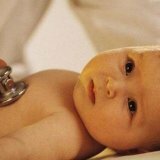Intracranial hypertension in children: treatment

Normally the child has mechanisms of natural regulation of cerebral circulation before birth. Its parameters do not depend on the change in the level of blood pressure. Intracranial hypertension may occur in a child in case of prematurity, various pathologies during pregnancy or during childbirth. In this case, the intensity of blood circulation in the brain is completely dependent on fluctuations in blood pressure. Increased pressure can lead to an increase in the volume of cerebrospinal fluid inside the brain cavities. The accumulation of excess volume of cerebrospinal fluid leads to an increase in its pressure on the brain tissue.
Causes of
The most common causes of intracranial hypertension in young children are intrauterine hypoxia( a state of insufficient oxygen supply to the fetus), asphyxia of newborns( a state of disturbance of gas exchange in the lungs), birth and postnatal cerebrovascular traumas, viral and bacterial infections( meningitis and encephalitis).Also, the causes may be: a disturbed outflow of venous blood from the cranial cavity, congenital features of the central nervous system.
Symptoms of
The syndrome of increased intracranial pressure in children is manifested by the bulging and strong tension of the fontanel, the apparent divergence of the seams between the main bones of the skull, the behavior change( the child becomes restless, often screams).Often a child has convulsions, trembling, vomiting, or regurgitation, not related to eating. There are also symptoms such as: increased pain sensitivity, violation of consciousness of varying severity. In the first year of life, the baby should carefully monitor the change in the circumference of the head. If the pathological process persists, and the treatment is not carried out - it threatens the further appearance of the child mental disorders, blindness, paralysis.
Older children with intracranial hypertension may complain of pain in the head of a bursting nature, frequent dizziness, nausea, aggravated during active movements, and vomiting. However, no symptom can be considered separately, as a clear sign of developing intracranial hypertension. If there are several symptoms, this is a good reason to take the child to a pediatrician and conduct a survey.
Treatment of
In the treatment of pediatric intracranial hypertension, if it is not accompanied by an increase in the volume of cerebrospinal fluid, strong diuretics are usually immediately assigned to adults) may not be prescribed. Showing such treatment tools as massage, exercise therapy, proper nutrition, swimming, correction of the regime of the day, more frequent and close communication of the baby with the parents.
In more severe and neglected cases, prescribe drugs that contribute to the outflow of fluid from the brain cavity. Diuretics( triampur, diacarb) have become very popular recently, but you can also give the child a decoction of celery, parsley, caraway tea - they all have a diuretic effect. It also applies to treatment aimed at accelerating blood circulation and stimulating brain nutrition. Doctors prescribe nootropic drugs( piracetam, cortexin, lucetam, ceraxone, cerebrolysin) and vascular drugs( nicergoline, sermion, nicotinic acid, cavinton).
In the most severe cases, surgical treatment is used. Usually it is necessary, if the doctors accurately determined the cause of the increase in the child's intracranial pressure and found out that in addition to the operation nothing else will help. So, with hydrocephalus, shunting operations are used when excess cerebrospinal fluid is artificially removed from the skull cavity. When a tumor is detected, it is removed, and if the infection is damaged by neuroinfection, antibiotics are administered.
Because children have very great recovery capabilities of the brain, most babies have intracranial hypertension on their own in the first six months of life. Sometimes an increased long time intracranial pressure in a child can lead to its lag in physical and mental development, hydrocephalus and epilepsy. Children with intracranial hypertension need special care, in a calm environment, which helps the early maturation of the child's nervous system and the normalization of pressure.



